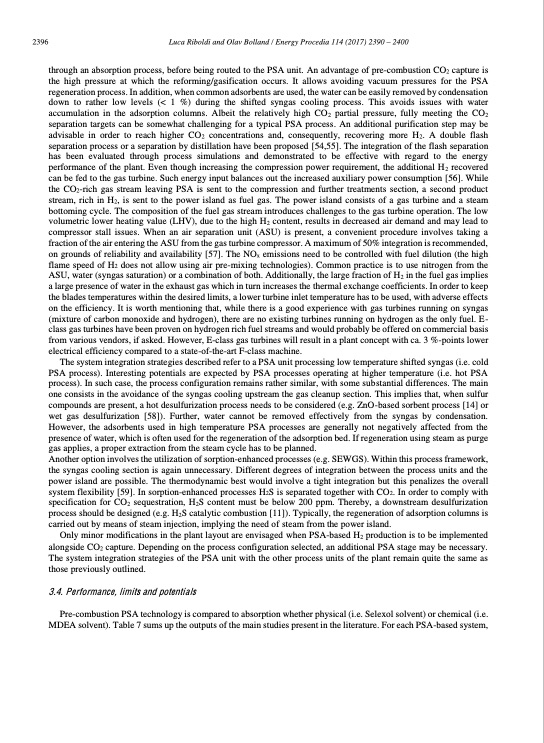
PDF Publication Title:
Text from PDF Page: 008
2396 Luca Riboldi and Olav Bolland / Energy Procedia 114 (2017) 2390 – 2400 through an absorption process, before being routed to the PSA unit. An advantage of pre-combustion CO2 capture is the high pressure at which the reforming/gasification occurs. It allows avoiding vacuum pressures for the PSA regeneration process. In addition, when common adsorbents are used, the water can be easily removed by condensation down to rather low levels (< 1 %) during the shifted syngas cooling process. This avoids issues with water accumulation in the adsorption columns. Albeit the relatively high CO2 partial pressure, fully meeting the CO2 separation targets can be somewhat challenging for a typical PSA process. An additional purification step may be advisable in order to reach higher CO2 concentrations and, consequently, recovering more H2. A double flash separation process or a separation by distillation have been proposed [54,55]. The integration of the flash separation has been evaluated through process simulations and demonstrated to be effective with regard to the energy performance of the plant. Even though increasing the compression power requirement, the additional H2 recovered can be fed to the gas turbine. Such energy input balances out the increased auxiliary power consumption [56]. While the CO2-rich gas stream leaving PSA is sent to the compression and further treatments section, a second product stream, rich in H2, is sent to the power island as fuel gas. The power island consists of a gas turbine and a steam bottoming cycle. The composition of the fuel gas stream introduces challenges to the gas turbine operation. The low volumetric lower heating value (LHV), due to the high H2 content, results in decreased air demand and may lead to compressor stall issues. When an air separation unit (ASU) is present, a convenient procedure involves taking a fraction of the air entering the ASU from the gas turbine compressor. A maximum of 50% integration is recommended, on grounds of reliability and availability [57]. The NOx emissions need to be controlled with fuel dilution (the high flame speed of H2 does not allow using air pre-mixing technologies). Common practice is to use nitrogen from the ASU, water (syngas saturation) or a combination of both. Additionally, the large fraction of H2 in the fuel gas implies a large presence of water in the exhaust gas which in turn increases the thermal exchange coefficients. In order to keep the blades temperatures within the desired limits, a lower turbine inlet temperature has to be used, with adverse effects on the efficiency. It is worth mentioning that, while there is a good experience with gas turbines running on syngas (mixture of carbon monoxide and hydrogen), there are no existing turbines running on hydrogen as the only fuel. E- class gas turbines have been proven on hydrogen rich fuel streams and would probably be offered on commercial basis from various vendors, if asked. However, E-class gas turbines will result in a plant concept with ca. 3 %-points lower electrical efficiency compared to a state-of-the-art F-class machine. The system integration strategies described refer to a PSA unit processing low temperature shifted syngas (i.e. cold PSA process). Interesting potentials are expected by PSA processes operating at higher temperature (i.e. hot PSA process). In such case, the process configuration remains rather similar, with some substantial differences. The main one consists in the avoidance of the syngas cooling upstream the gas cleanup section. This implies that, when sulfur compounds are present, a hot desulfurization process needs to be considered (e.g. ZnO-based sorbent process [14] or wet gas desulfurization [58]). Further, water cannot be removed effectively from the syngas by condensation. However, the adsorbents used in high temperature PSA processes are generally not negatively affected from the presence of water, which is often used for the regeneration of the adsorption bed. If regeneration using steam as purge gas applies, a proper extraction from the steam cycle has to be planned. Another option involves the utilization of sorption-enhanced processes (e.g. SEWGS). Within this process framework, the syngas cooling section is again unnecessary. Different degrees of integration between the process units and the power island are possible. The thermodynamic best would involve a tight integration but this penalizes the overall system flexibility [59]. In sorption-enhanced processes H2S is separated together with CO2. In order to comply with specification for CO2 sequestration, H2S content must be below 200 ppm. Thereby, a downstream desulfurization process should be designed (e.g. H2S catalytic combustion [11]). Typically, the regeneration of adsorption columns is carried out by means of steam injection, implying the need of steam from the power island. Only minor modifications in the plant layout are envisaged when PSA-based H2 production is to be implemented alongside CO2 capture. Depending on the process configuration selected, an additional PSA stage may be necessary. The system integration strategies of the PSA unit with the other process units of the plant remain quite the same as those previously outlined. 3.4. Performance, limits and potentials Pre-combustion PSA technology is compared to absorption whether physical (i.e. Selexol solvent) or chemical (i.e. MDEA solvent). Table 7 sums up the outputs of the main studies present in the literature. For each PSA-based system,PDF Image | Pressure Swing Adsorption (PSA) as CO2 Capture Technology

PDF Search Title:
Pressure Swing Adsorption (PSA) as CO2 Capture TechnologyOriginal File Name Searched:
PSA-co2-capture.pdfDIY PDF Search: Google It | Yahoo | Bing
CO2 Organic Rankine Cycle Experimenter Platform The supercritical CO2 phase change system is both a heat pump and organic rankine cycle which can be used for those purposes and as a supercritical extractor for advanced subcritical and supercritical extraction technology. Uses include producing nanoparticles, precious metal CO2 extraction, lithium battery recycling, and other applications... More Info
Heat Pumps CO2 ORC Heat Pump System Platform More Info
| CONTACT TEL: 608-238-6001 Email: greg@infinityturbine.com | RSS | AMP |